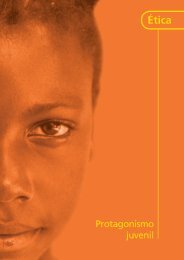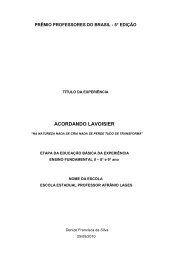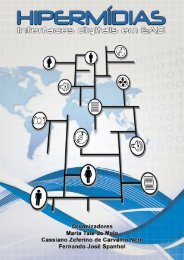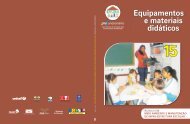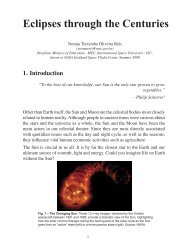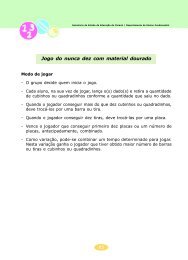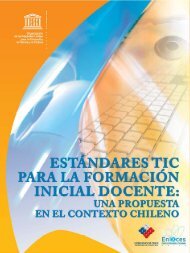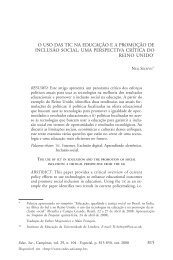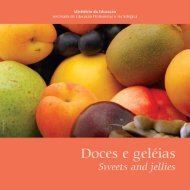BIO-CULTURAL COMMUNITY PROTOCOLS - Portal do Professor
BIO-CULTURAL COMMUNITY PROTOCOLS - Portal do Professor
BIO-CULTURAL COMMUNITY PROTOCOLS - Portal do Professor
You also want an ePaper? Increase the reach of your titles
YUMPU automatically turns print PDFs into web optimized ePapers that Google loves.
PART I / CHAPTER 2<br />
Conservation farming: Through Gunis’ knowledge, some of<br />
our community members have begun to grow medicinal plants<br />
for the local and regional market. While being distinct from<br />
Gunis, we include medicinal plants’ conservation farmers in<br />
this group. We are able to buy low cost plants directly from the<br />
farmers. The farmers constitute 20 to 30 families who employ<br />
indigenous farming methods, including no use of pesticides<br />
or herbicides that adversely affect microorganisms and other<br />
life forms beneficial to the environment. 8<br />
3.3.2 Animal Genetic Resources and Culture<br />
Both the Samburu and the Raika expressed a deep connection<br />
to their livestock and explained how they sustained particular<br />
indigenous breeds. The Raika, for example, state the following:<br />
Through our interaction with the forests, gauchar and oran,<br />
and through selective breeding for generations we have<br />
created breeds that are particularly hardy, able to forage and<br />
digest rough vegetation, withstand the dry Rajasthani<br />
environment, and walk long distances – all attributes that<br />
“high performance” exotic breeds <strong>do</strong> not have. Local breeds<br />
need fewer inputs and are less susceptible to disease and are<br />
well-suited to harsh conditions. The animal genetic diversity<br />
they embody enables us to respond to changes in the natural<br />
environment, important attributes in the context of climate<br />
change adaptation and food security. Their genetic traits and<br />
our traditional knowledge associated with them will also be<br />
of use in breeding for disease resistance, and may provide us<br />
with other diverse economic opportunities under the<br />
forthcoming International Regime on Access and Benefit<br />
Sharing or a future International Treaty on Animal Genetic<br />
Resources for Food and Agriculture. 9<br />
The Samburu echo this idea in their respective context:<br />
We keep the small East African Zebu cattle, Red Maasai sheep<br />
and East African goats. Our indigenous breeds are particularly<br />
suited to local conditions because of adaptation through<br />
natural selection, as well as our contribution to their genetic<br />
development through selective breeding. Until the recent<br />
introduction of exotic breeds, these were the only breeds we<br />
kept, representing hundreds of years of co-development<br />
between our livestock, the environment and our way of life.<br />
We particularly value their abilities to withstand drought, to<br />
walk long distances and survive on small quantities of rough<br />
vegetation, as well as their strong resistance to disease. Because<br />
these breeds are integral to our lives, we also have a wealth of<br />
knowledge about them, including breeding methods<br />
and animal health knowledge.<br />
Our indigenous breeds and their characteristics are the result<br />
of our relationship with the land, and as a result we see them<br />
as part of our cultural heritage. We have learned that our<br />
breeds are also considered important by others because of<br />
their hardiness and disease resistance.<br />
Our culture and animal breeds are integral to who we are<br />
as a People. Without our indigenous breeds we will have<br />
lost a critical part of our collective bio-cultural heritage,<br />
and without our culture our indigenous breeds are less<br />
likely to be conserved. 10<br />
3.4 Bio-spirituality<br />
<strong>BIO</strong>-<strong>CULTURAL</strong> <strong>COMMUNITY</strong> <strong>PROTOCOLS</strong> AS A<br />
<strong>COMMUNITY</strong>-BASED RESPONSE TO THE CBD<br />
Closely linked to the above is the spiritual connection that all<br />
communities spoke about but that was most highlighted by<br />
the traditional healers. The Bushbuckridge traditional healers<br />
living in the Kruger to Canyons Biosphere Reserve state how<br />
their spirituality guards against the over-harvesting of any of<br />
their natural resources:<br />
Our harvesting of medicinal plants is guided by our spiritual<br />
values and is regulated by our customary laws that promote<br />
the sustainability of our natural resources. For example, we<br />
ask our ancestors as we harvest to ensure that the medicines<br />
will have their full effect, and believe that only harvested leaves<br />
or bark that are taken in ways that ensure the survival of the<br />
plant or tree will heal the patient. This means that we take<br />
only strips of bark or selected leaves of stems of plants, and<br />
always cover the roots of trees or plants after we have collected<br />
what we require. Also, we have rules linked to the seasons in<br />
which we can collect various plants, with severe consequences<br />
such as jeopardizing rains if they are transgressed. Because<br />
we harvest for immediate use, we never collect large scale<br />
amounts of any particular resource, tending to collect a<br />
variety of small samples. This inhibits over-harvesting.<br />
8. Biocultural Community Protocol of Gunis and Medicinal Plant Conservation Farmers of Rajasthan, India. For more information contact Bhawar Dhabai or Ganesh Purohit,<br />
Jagran Jan Vikas Samiti, www.jjvs.org.<br />
9. Supra note 4.<br />
10. Supra note 2.<br />
25




